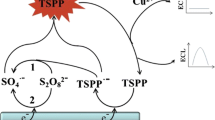Abstract
An electrochemiluminescence (ECL) analytical device was developed using an electric contactless power transfer system. A mutually induced electromotive voltage was generated by wrapping an enameled wire around a commercial contactless charger. There was no electrical contact between the power supply and the electrochemical cell. For the tris(2,2′-bipyridine)ruthenium(II) (Ru(bpy)32+)/tri-n-propylamine system, a weak ECL signal was observed. When an inexpensive rectifier diode was introduced between the coil and the working electrode, the ECL intensity detection sensitivity increased by more than 100 times. The relationship between the waveform of the applied voltage and the ECL response was clarified, and the optimum conditions were determined. The intensity of the induced electromotive voltage was easily controlled by changing the number of turns in the coil. The proposed method is a safe, simple, and inexpensive technique without electrical contact.
Similar content being viewed by others
References
Z. Bi, T. Kan, C. Mi, Y. Zhang, Z. Zhao, and G. Keoleian, Appl. Energy, 2016, 179, 413.
S. Khan, S. Pavuluri, G. Cummins, and M. Desmulliez, Sensors, 2020, 20, 3487.
A. J. Bard, “Electrogenerated Chemiluminescence“”, 2004, Dekker, New York.
J. L. Delaney, C. F. Hogan, J. Tian, and W. Shen, Anal. Chem., 2011, 83, 1300.
A. Knight, Trends Anal. Chem., 1999, 18, 47.
W. Miao, Chem. Rev., 2008, 108, 2506.
X. Ma, L. Qi, W. Gao, F. Yuan, Y. Xia, B. Lou, and G. Xu, Electrochim. Acta, 2019, 308, 20.
W. Qi, J. Lai, W. Gao, S. Li, S. Hanif, and G. Xu, Anal. Chem., 2014, 86, 8927.
L. Qi, Y. Xia, W. Qi, W. Gao, F. Wu, and G. Xu, Anal. Chem., 2016, 88, 1123.
Y. Dai and C. Liu, Angew. Chem. Int. Ed., 2019, 58, 12355.
X. Yin, S. Dong, and E. Wang, Trends Anal. Chem., 2004, 23, 432.
F. Takahashi, S. Nitta, R. Shimizu, and J. Jin, Forensic Toxicol., 2018, 36, 185.
F. Takahashi, R. Shimizu, T. Nakazawa, and J. Jin, Ultrason. Sonochem., 2020, 63, 104947.
H. Li, N. Lopes, S. Moser, G. Sayler, and S. Ripp, Biosens. Bioelectron., 2012, 33, 299.
M. Neves, P. Bobes-Limenes, A. Perez-Junquera, M. B. Gonzalez-Garcia, D. Hernandez-Santos, and P. Fanjul- Bolado, Anal. Bioanal. Chem., 2016, 408, 7121.
W. Dai, W. Zhao, Y. Ma, J. Ye, and J. Jin, Electroanalysis, 2020, 32, 2018.
W. Lee, Microchim. Acta, 1997, 127, 19.
R. J. Forster, P. Bertoncello, and T. E. Keyes, Ann. Rev. Anal. Chem., 2009, 2, 359.
F. Takahashi and J. Jin, Electroanalysis, 2008, 20, 1581.
Acknowledgements
This work was supported by the Japan Society for the Promotion of Science (JSPS) through a Grant-in-Aid for Scientific Research (C) [Grant Number 20K10553]. Part of this work was supported by the Researcher Assistance Program from the Shinshu University Gender Equality Promotion Centre and discretionary expenses of the Dean of the Faculty of Science of Shinshu University. We are grateful to Mr. Lloyd Teh Tzer Tong, Ms. Ayae Takizawa, and Mr. Ken'ichi Ichikawa for their cooperative involvement in designing and implementing the MPPC experimental device ECL measurements. We thank Gabrielle David, PhD, from Edanz Group (https://en-author-services. edanz.com/ac) for editing a draft of this manuscript.
Author information
Authors and Affiliations
Corresponding author
Electronic supplementary material
Rights and permissions
About this article
Cite this article
Takahashi, F., Tanaka, R., Arai, Y. et al. Electrochemiluminescence of Tris(2,2′-bipyridine)ruthenium(II)/Tri-n-propylamine with an Electric Contactless Power Transfer System. ANAL. SCI. 37, 1309–1313 (2021). https://doi.org/10.2116/analsci.21A002
Received:
Accepted:
Published:
Issue Date:
DOI: https://doi.org/10.2116/analsci.21A002




